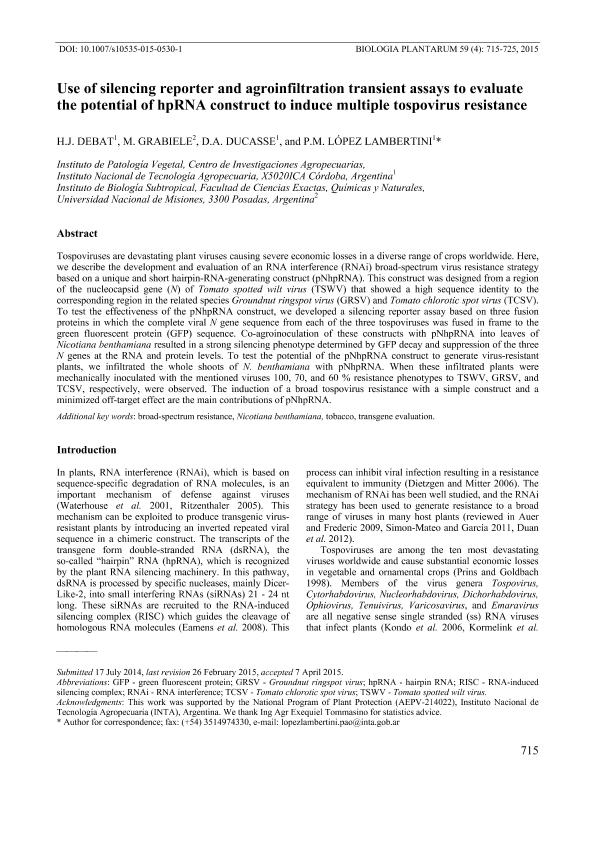Artículo
Use of silencing reporter and agroinfiltration transient assays to evaluate the potential of hpRNA construct to induce multiple tospovirus resistance
Fecha de publicación:
12/2015
Editorial:
Springer
Revista:
Biologia Plantarum
ISSN:
0006-3134
Idioma:
Inglés
Tipo de recurso:
Artículo publicado
Clasificación temática:
Resumen
Tospoviruses are devastating plant viruses causing severe economic losses in a diverse range of crops worldwide. Here, we describe the development and evaluation of an RNA interference (RNAi) broad-spectrum virus resistance strategy based on a unique and short hairpin-RNA-generating construct (pNhpRNA). This construct was designed from a region of the nucleocapsid gene (N) of Tomato spotted wilt virus (TSWV) that showed a high sequence identity to the corresponding region in the related species Groundnut ringspot virus (GRSV) and Tomato chlorotic spot virus (TCSV). To test the effectiveness of the pNhpRNA construct, we developed a silencing reporter assay based on three fusion proteins in which the complete viral N gene sequence from each of the three tospoviruses was fused in frame to the green fluorescent protein (GFP) sequence. Co-agroinoculation of these constructs with pNhpRNA into leaves of Nicotiana benthamiana resulted in a strong silencing phenotype determined by GFP decay and suppression of the three N genes at the RNA and protein levels. To test the potential of the pNhpRNA construct to generate virus-resistant plants, we infiltrated the whole shoots of N. benthamiana with pNhpRNA. When these infiltrated plants were mechanically inoculated with the mentioned viruses 100, 70, and 60 % resistance phenotypes to TSWV, GRSV, and TCSV, respectively, were observed. The induction of a broad tospovirus resistance with a simple construct and a minimized off-target effect are the main contributions of pNhpRNA.
Archivos asociados
Licencia
Identificadores
Colecciones
Articulos(IBS)
Articulos de INSTITUTO DE BIOLOGIA SUBTROPICAL
Articulos de INSTITUTO DE BIOLOGIA SUBTROPICAL
Citación
Debat, Humberto Julio; Grabiele, Mauro; Ducasse, Daniel Adrián; López Lambertini, Paola María; Use of silencing reporter and agroinfiltration transient assays to evaluate the potential of hpRNA construct to induce multiple tospovirus resistance; Springer; Biologia Plantarum; 59; 4; 12-2015; 715-725
Compartir
Altmétricas




